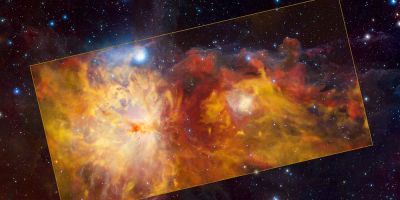 Do not be deceived by the picture and the name of the cosmic object depicted! What you see in this image is not a wildfire, but the Flame Nebula and its surroundings, captured at radio wavelengths.
Do not be deceived by the picture and the name of the cosmic object depicted! What you see in this image is not a wildfire, but the Flame Nebula and its surroundings, captured at radio wavelengths.
Photo: ESO/Th. Stanke & ESO / J. Emerson / Vista. Acknowledgments: Cambridge Astronomical Survey Unit
Orion has an amazing fireworks display in store for the upcoming holidays. But rest assured, this iconic zodiac sign doesn’t really flirt. The “fire” you see in this new image from the European Southern Observatory (ESO) is the Flame Nebula in Orion, captured at radio wavelengths, an image that certainly lives up to the nebula’s name! The image was taken using the Atacama Pathfinder Experiment (APEX) operated by ESO, centered on the cold Chajnantor Plateau in Chile’s Atacama Desert.
The newly modified image of the Flame Nebula, which also shows smaller nebulae such as the Horsehead Nebula, is based on observations made by former ESO astronomer Thomas Stanke and his team several years ago. They wanted to test the newly installed SuperCam instrument on APEX and point it toward the Orion constellation. “Astronomers know: when a new telescope or instrument becomes available, you have to look at Orion: there is always something new and interesting to discover!” says Stanke. After several years and many observations thereafter, Stanke and his team’s findings have now been accepted for publication in the Journal of Astronomy and Astrophysics.
In Orion, one of the most famous regions of the sky, are the nearest giant molecular clouds – huge cosmic complexes consisting mainly of hydrogen, where new stars and planets are formed. Located 1,300 to 1,600 light-years away, these clouds include the most active stellar nurseries near our solar system, and the Flame Nebula pictured here. At the center of this “emission nebula” is a group of young stars that illuminate the surrounding gas with their high-energy radiation.
In addition to the Flame Nebula and its surroundings, Stanke and his collaborators were able to enjoy a whole host of other great things. Some examples are the reflection nebulae Messier 78 and NGC 2071 – clouds of interstellar gas and dust believed to reflect light from nearby stars. The team even discovered a new nebula: a small object distinguished by its near-perfect circular shape, which they call cowhide.
The observations were made as part of the APEX Large CO Heterodyne Orion Legacy Survey (ALCOHOLS), which examined radio waves emitted by carbon monoxide (CO) in the Orion cloud. Harnessing this molecule to survey large swaths of the sky is the main goal of SuperCam, as it allows astronomers to map the large gas clouds that make up new stars. Contrary to what the “fire” in this image suggests, these clouds are extremely cold: their temperatures are no more than a few tens of degrees above absolute zero.
Due to the many secrets this sky region can reveal, it has been photographed many times in the past in all kinds of wavelengths. One example is infrared observations made with ESO’s Visible and Infrared Survey Telescope (VISTA) at Paranal Observatory in Chile, which provides the quiet background for this image of the Flame Nebula and its surroundings. In each wavelength range, molecular clouds exhibit different unique properties. Unlike visible light, infrared waves pass through thick clouds of interstellar dust, allowing astronomers to see stars and other objects that would otherwise remain hidden.
This stunning multi-wavelength fireworks display at Orion is brought to you by ESO for the upcoming festive season!
source: who – which

“Lifelong entrepreneur. Total writer. Internet ninja. Analyst. Friendly music enthusiast.”












More Stories
Monster Jam Showdown Launch Trailer
The European Digital Twin Ocean prototype reveals many possibilities
Instagram now lets you add a song to your account